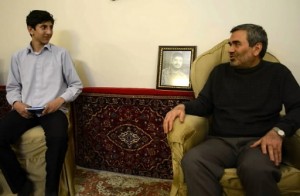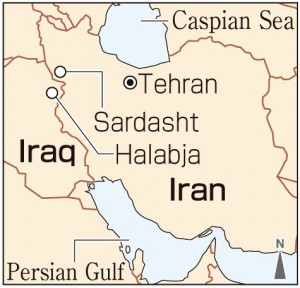Students in Iran, inspired by students in Hiroshima, interview poison gas survivors to convey facts to future generations
Aug. 29, 2014
by Rie Nii, Staff Writer
The “Junior Writer Project” has been launched in Iran to convey the experiences of the survivors of the poison gas attacks that took place during the Iran-Iraq War. In this project, “junior writers,” consisting of elementary school students through high school students in Tehran, the capital, are interviewing poison gas survivors to produce booklets about their lives. They are also shooting video footage to create a series of DVDs.
The project was conceived when four kindergarten and elementary school teachers from Iran visited Hiroshima in July 2013 and learned about peace education from staff members of the Hiroshima City Board of Education. On August 6 of last year, poison gas survivors from Iran were interviewed by junior writers of the Chugoku Shimbun, and the teachers witnessed the importance of conveying the facts to future generations.
The students serving as junior writers are asking the survivors about their experiences of the poison gas attacks, their health conditions now, and other aspects of their lives. So far, they have interviewed two survivors. They will make a booklet and a DVD about each survivor, and these materials will be made available at the Tehran Peace Museum in the city of Tehran.
Many of the poison gas survivors are over 40 years old and suffer from ailments to their bronchi, lungs, eyes, and skin. Asadollah Mohammadi, a 15-year-old high school freshman who interviewed a survivor said, “I was moved to see and hear about the sacrifices made by the victims. I’m determined to do what I can to build a better society so they will not have suffered in vain.”
Keywords
Poison gas attacks during the Iran-Iraq War
During the Iran-Iraq War (1980-88), Iraqi forces reportedly used mustard gas and nerve gas against Iran. According to the Atlas of Mustard Gas Injuries, which gives a graphic account of poison gas victims in Japan and Iran, more than 100,000 Iranians were affected by these chemical weapons, undergoing emergency treatment and hospital care.
Chemical weapons were first used against Iranian forces along the border. In June 1987, they were used for the first time against civilians. In Sardasht, in the northern part of Iran, 110 people died within several days among a population of about 12,000 people. In March 1988, more than 5,000 people were killed in Halabja, a town in Iraq near the border with Iran.
(Originally published on August 25, 2014)









